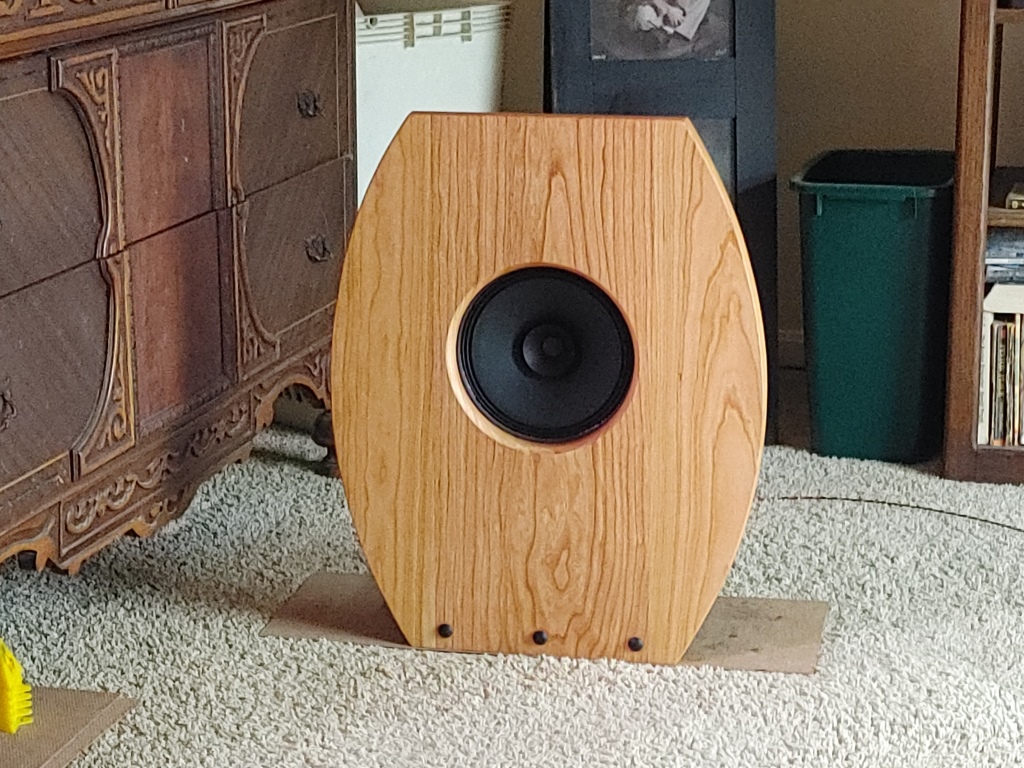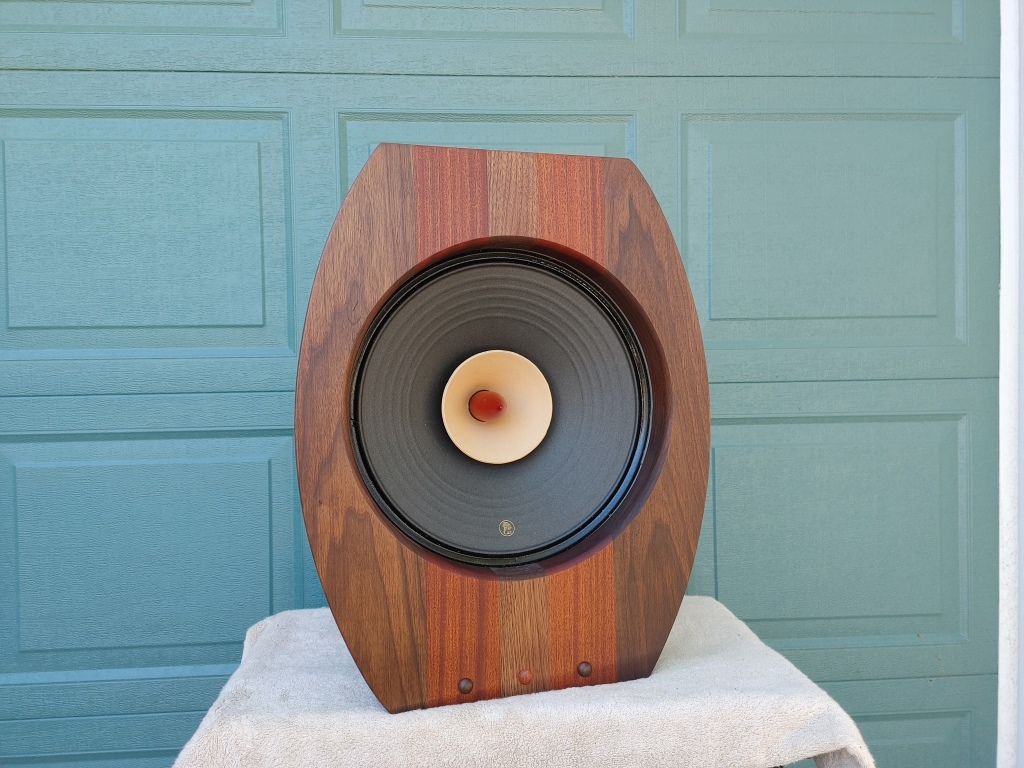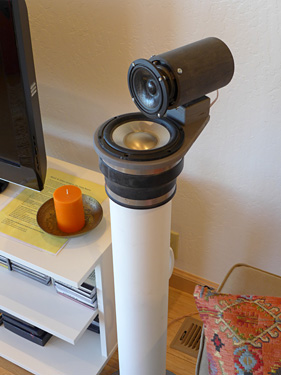That makes a huge difference already.No, and more of a rectangle than a cube (as most speakers).
-
WANTED: Happy members who like to discuss audio and other topics related to our interest. Desire to learn and share knowledge of science required. There are many reviews of audio hardware and expert members to help answer your questions. Click here to have your audio equipment measured for free!
You are using an out of date browser. It may not display this or other websites correctly.
You should upgrade or use an alternative browser.
You should upgrade or use an alternative browser.
Is baffle shape really important? What about these ideas?
- Thread starter GM3
- Start date
mhardy6647
Grand Contributor
- Joined
- Dec 12, 2019
- Messages
- 11,373
- Likes
- 24,585
Baffle shape is very important, if you wanna see how far you need to go to completely eliminate diffraction check out the blade series from KEF.
"Your speaker has to look like a spaceship or it will suffer from crazy diffraction issues"
"MDF is a horrible material"
"beryllium tweeter or it's crap"
A baffle can be a great many shapes and be part of an awesome speaker as long as the designer knows what she is doing.
this obviously has baffle step compensation right? you can't really compare it then. it doesn't make sense.
Of course, but that isn't difficult to implement, and any sane speaker designer would do that with a traditional speaker. This forum is great at talking in black and white, which makes it hard for people to understand what's important and not, and to what extent something has a meaningful impact or not.
AFAIK baffle shape matters for two reasons:
1) The size of the front face influences the minimum frequency where you can get directivity. Basically once the wavelength exceeds the front dimensions, the waves start going sideways/backwards instead of mostly forward. This is why extra-wide baffles are sometimes seen as desirable.
2) Diffraction - waves will diffract at any feature that is similar in size to the wavelength. Since audio wavelengths get up to 10+ feet in most speakers, a sphere or other similarly rounded-off shape minimizes the effects of diffraction, hence the sphere looking good in that comparison chart. Diffraction is more of a problem in high frequencies (small wavelengths), so that's why simply rounding off the edges of the box is still pretty useful despite being small relative to some wavelengths.
1) The size of the front face influences the minimum frequency where you can get directivity. Basically once the wavelength exceeds the front dimensions, the waves start going sideways/backwards instead of mostly forward. This is why extra-wide baffles are sometimes seen as desirable.
2) Diffraction - waves will diffract at any feature that is similar in size to the wavelength. Since audio wavelengths get up to 10+ feet in most speakers, a sphere or other similarly rounded-off shape minimizes the effects of diffraction, hence the sphere looking good in that comparison chart. Diffraction is more of a problem in high frequencies (small wavelengths), so that's why simply rounding off the edges of the box is still pretty useful despite being small relative to some wavelengths.
Last edited:
Just about the worst thing you can do unless you hate bass, and want Doppler distortion. But I cast no stones if they like that kind of thing...
A baffle can be a great many shapes and be part of an awesome speaker as long as the designer knows what she is doing.
Honestly most speaker designers default to the rectangle shaped baffles because that's the easiest one to make, lets not fool ourselves. I see no reason not to make interesting smooth shaped baffles to fit the radiation pattern that you want.
Everything less than the ideal spherical shape is a compromise. KEF understands this well with their LS50 and Blade series.
I really wish the DIY community moves towards 3D printing. but that seems to be taking longer than I expected.
From the man who wrote the book in 1940. Here is a more recent edition; a must read…Where is this from again? Not sure how accurate it is…
valerianf
Addicted to Fun and Learning
If manufacturers want a classic and low cost rectangular shape cabinets, at least they can place round corners.
And Philarmonic Audio is showing us that it is possible to have beautiful rounded cabinets that provide a great sound quality.


And Philarmonic Audio is showing us that it is possible to have beautiful rounded cabinets that provide a great sound quality.


Interesting, no mention or graph of a unbroken flat wall.
Anyway, the point is that diffraction on regular, traditionally shaped speakers is typically not a massive problem.
My understanding is that Harry Olson's graphic depictions of diffraction are based on a very small diameter driver, like 1" or so, on a baffle that is about one meter wide. So the radiation pattern of the driver itself is very wide and therefore very strongly "illuminates" the baffle edges at the frequencies where those big peaks and dips occur.
In the real world we'd normally be using much larger diameter drivers at those frequencies, resulting in a narrower radiation pattern with correspondingly weaker "illumination" of the cabinet edges and therefore smaller frequency-response disturbances. We'd also normally be using much smaller baffles, which pushes the ripples higher in frequency.
In practice I normally see "one hump" in the time-gated data, corresponding with the lowest frequency hump predicted by Olsen, and the hump's exact frequency is somewhat measurement-geometry dependent. Above the hump the response tends to be fairly smooth (assuming the driver itself is smooth), and below the hump is the baffle-step rolloff.
Last edited:
Honestly most speaker designers default to the rectangle shaped baffles because that's the easiest one to make, lets not fool ourselves. I see no reason not to make interesting smooth shaped baffles to fit the radiation pattern that you want.
Everything less than the ideal spherical shape is a compromise. KEF understands this well with their LS50 and Blade series.
I really wish the DIY community moves towards 3D printing. but that seems to be taking longer than I expected.
I generally agree, I mostly commented on OPs "I'm also wondering if diffraction is just overblown" - which I think to an extent it is.
Personally I obviously care about diffraction and radiation pattern given the baffle and overall design of the Manta. But in general there are a whole lot of other things that can go wrong as well, while a well designed traditional rectangle shaped baffle (even with a pretty hard edge) can be made to sound pretty darn good, and have pretty good dispersion too. Going back to Kef, they're proving that with their R and Reference series.
Agree... I plan to do some really wacky DIY 3D printed enclosures at some point, but I need to finish my 3D printed coffee table first or my wife will kill me.Honestly most speaker designers default to the rectangle shaped baffles because that's the easiest one to make, lets not fool ourselves.
I really wish the DIY community moves towards 3D printing. but that seems to be taking longer than I expected.
The main reasons that 3D printed enclosures are less common in DIY, that I've seen:
- Most DIY speaker builders are decent woodworkers, but not too many have CAD skills that enable designing enclosures that are much more interesting than boxes. I've seen maybe 5 people post such projects on DIY audio in 2 years.
- Affordable 3D printers are basically always too small to print a speaker enclosure. You can still do it, but you need to spend significant time and effort designing it to be printed in pieces and then put it together later, AND have it be airtight when you're done. For all but the most seasoned 3D printing enthusiasts, building a large horn or 3-way that way is out of the question. Even among people who 3D print simply because they like 3D printing stuff, doing big multi-part prints is unusual.
- 3D printing services charge too much for prints large enough to use for enclosures. Even a small bookshelf enclosure could be a few hundred dollars.
- 3D printed structures are generally (IMO) not stiff enough to be taken seriously as speaker cabinets compared to MDF*. So if you are both a serious DIYer and committed to 3D printing, you need to either use fairly extreme print settings (with high cost of material) or fill the voids with something, which I have rarely if ever seen someone do.
*That said, I think it might be possible to work with this, rather than against it. By designing the interior of the cabinet with several thin, flexible layers, you could deliberately introduce a lot of flex, but also a lot of damping. You can more or less fill the space between layers with little plastic springs. Add a couple thicker layers on the outside, and you may have a better result than using one thick, stiff layer?
Last edited:
Honestly most speaker designers default to the rectangle shaped baffles because that's the easiest one to make, lets not fool ourselves. ,
But this is a fair trade-off to make isn't it, at least for commercial speakers (DIY is different). Weird shapes will be much more expensive to both design and produce, for relatively small benefits.
Some thoughts:
Olson's examples are worst case scenarios in many regards, using a source with extremely low directivity and placing it in non-ideal structures with the worst possible placement. If your source is meaningfully directional at the frequency which the baffle interactions occur you lessen them, because less sound reaches the edge and is reflected back to interfere with the direct sound.
Diffraction is not inherently bad, and can be used to extend the low-frequency directivity of a speaker or ameliorate other directivity aberrations. Since the frequency response aberrations introduced by edge diffraction primarily exist on-axis and dissappear as you move off-axis. This means that a peak in on-axis response due to diffraction doesn't exist off-axis (unlike, say, a resonance). If my cabinet introduces a 2dB peak on-axis at some frequency range due to diffraction and I equalize this down or fix it in the crossover then the off-axis response becomes 2dB lower, effectively making the loudspeaker more directional! A similar concept can be utilized to smooth out irregularities in waveguided tweeters or midranges. If my waveguide has a slight narrowing in the beamwidth at some frequency I can try to introduce a small diffraction dip at this frequency, which after equalization effectively rises the response off-axis.
Note that the above is not simple to do, and requires adequate simulation tools (e.g. AKABAK) or significant trial and error. If you want a response that is easy to work with and highly predictable, a sphere is of course ideal, just be aware that its DI will approach 0dB at a higher frequency than a similarly sized rectangular box. There's honestly a lot more that can be written about diffraction, but I'll end it here and say that I think it gets a bit of a bad rep when it is actually just another interesting tool in a designer's toolkit.
As an anecdotal example: when I was designing my midrange waveguide for a speaker project I am working on, I found that a 350mm wide cabinet without roundovers yielded a smoother directivity than a 370mm cabinet with 30mm roundovers! The effects were marginal, but they were there.
Olson's examples are worst case scenarios in many regards, using a source with extremely low directivity and placing it in non-ideal structures with the worst possible placement. If your source is meaningfully directional at the frequency which the baffle interactions occur you lessen them, because less sound reaches the edge and is reflected back to interfere with the direct sound.
Diffraction is not inherently bad, and can be used to extend the low-frequency directivity of a speaker or ameliorate other directivity aberrations. Since the frequency response aberrations introduced by edge diffraction primarily exist on-axis and dissappear as you move off-axis. This means that a peak in on-axis response due to diffraction doesn't exist off-axis (unlike, say, a resonance). If my cabinet introduces a 2dB peak on-axis at some frequency range due to diffraction and I equalize this down or fix it in the crossover then the off-axis response becomes 2dB lower, effectively making the loudspeaker more directional! A similar concept can be utilized to smooth out irregularities in waveguided tweeters or midranges. If my waveguide has a slight narrowing in the beamwidth at some frequency I can try to introduce a small diffraction dip at this frequency, which after equalization effectively rises the response off-axis.
Note that the above is not simple to do, and requires adequate simulation tools (e.g. AKABAK) or significant trial and error. If you want a response that is easy to work with and highly predictable, a sphere is of course ideal, just be aware that its DI will approach 0dB at a higher frequency than a similarly sized rectangular box. There's honestly a lot more that can be written about diffraction, but I'll end it here and say that I think it gets a bit of a bad rep when it is actually just another interesting tool in a designer's toolkit.
As an anecdotal example: when I was designing my midrange waveguide for a speaker project I am working on, I found that a 350mm wide cabinet without roundovers yielded a smoother directivity than a 370mm cabinet with 30mm roundovers! The effects were marginal, but they were there.
Wouldn’t a dome tweeter, which is used by a vast majority of speakers is the similar size?My understanding is that Harry Olson's graphic depictions of diffraction are based on a very small diameter driver, like 1" or so, on a baffle that is about one meter wide. So the radiation pattern of the driver itself is very wide and therefore very strongly "illuminates" the baffle edges at the frequencies where those big peaks and dips occur.
In the real world we'd normally be using much large diameter drivers at those frequencies, resulting in a narrower radiation pattern with correspondingly weaker "illumination" of the cabinet edges and therefore smaller frequency-response disturbances.
That is true, however Olson tested speakers on various shaped enclosures including spheres and cubes; do you think he used enclosures the size of a cube metre, or a big enough to carry a tonne of water?We'd also normally be using much smaller baffles, which pushes the ripples higher in frequency.
Wouldn’t a dome tweeter, which is used by a vast majority of speakers is the similar size?
Olson's diagrams are showing response down to 100 Hz with the first significant diffractive peak in the 300 Hz ballpark, roughly a decade below where 1" dome tweeters typically come in.
That is true, however Olson tested speakers on various shaped enclosures including spheres and cubes; do you think he used enclosures the size of a cube metre, or a big enough to carry a tonne of water?
Imo the lowest frequencies of the response peaks are consistent with speaker enclosures in that size ballpark. I've measured rectangular speakers about half that width and their diffraction peak is at about twice the frequency of his lowest peaks.
That being said, I recall reading somewhere that Olsen did not actually build and test the enclosures (or not all of them), that those graphs were calculated rather than measured, which seems plausible considering the unlikelihood of his having access to a 1" driver that was smooth from 100 Hz to 4 kHz.
Last edited:
I see Olson’s charts as examples of how diffraction works. I expected him to specifically exaggerate the effect by using smaller emitters on larger baffles.Olson's diagrams are showing response down to 100 Hz with the first significant diffractive peak in the 300 Hz ballpark, roughly a decade below where 1" dome tweeters typically come in.
During the design of Silver 5L I calculated and investigated the diffraction effects that happened at the frequencies where the tweeter operate (>1500Hz). As per this understanding I expect negative effects will be present on wide baffle speakers that use small diameter drivers like big ATC models.
radix
Major Contributor
- Joined
- Aug 1, 2021
- Messages
- 1,397
- Likes
- 1,334
During the design of Silver 5L I calculated and investigated the diffraction effects that happened at the frequencies where the tweeter operate (>1500Hz). As per this understanding I expect negative effects will be present on wide baffle speakers that use small diameter drivers like big ATC models.
Maybe the shallow horn around that big 3" ATC dome midrange introduces enough directionality to minimize the baffle edge diffraction ripples?
Similar threads
- Replies
- 24
- Views
- 2K
- Replies
- 19
- Views
- 2K
- Replies
- 77
- Views
- 7K



